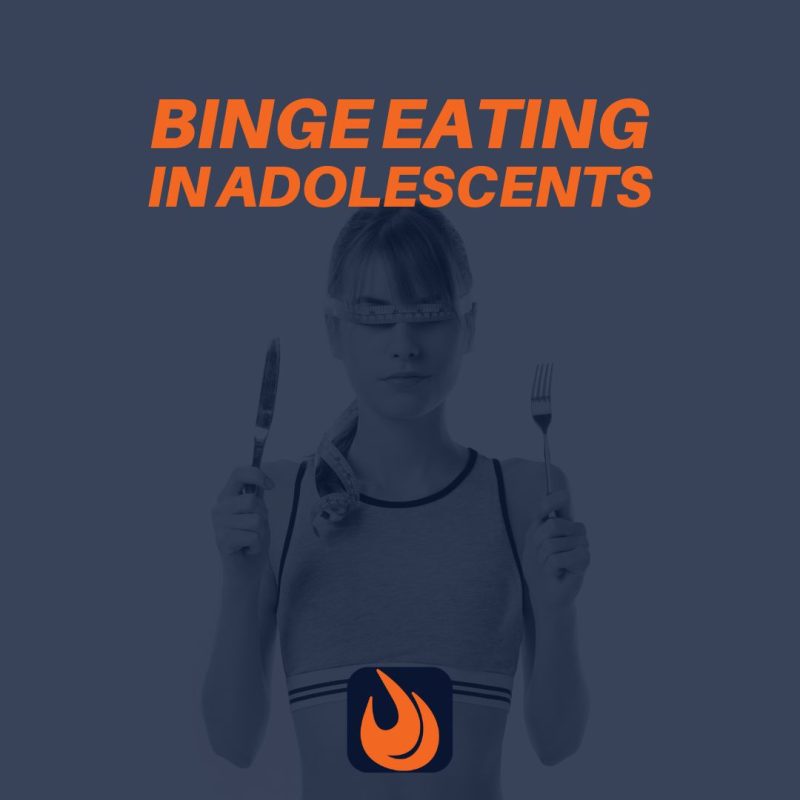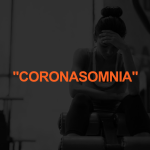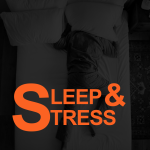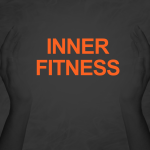
When personal trainers hear the term “eating disorders”, extreme caloric restriction, or anorexia, might come to mind before binge eating. As such, it may be surprising to learn that both Binge Eating Disorder (BED) and Bulimia Nervosa (BN) are more common medical diagnoses than Anorexia Nervosa (AN). A 2020 report by Deloitte estimates the number of cases between 2018-2019 within the US at 408,000 for AN, 621,900 for BN, and a staggering 2,033,300 for BED.
Eating disorders (EDs) and disordered eating behaviors present in numerous forms, and can affect individuals of all ages, body sizes, ethnicities, genders, and sexualities. As the median age of onset for binge eating is 17-22 years old, this discussion will focus primarily on adolescents. Since adolescence can be a difficult point in life physically, cognitively, and socially, disordered eating behaviors may emerge during this time as a maladaptive coping mechanism for stress.
At the core of being an effective personal trainer is promoting complete wellness and well-being in clients, so it is crucial to develop a functional understanding of binge eating behaviors to help ensure and protect the health of all clients. Here’s what health and fitness coaches need to know about this alarming condition.
What Defines Binge Eating?
The American Psychiatric Association’s Diagnostic and Statistical Manual of Mental Disorders 5th edition (DSM-5) defines binge eating as: Consuming an amount of food significantly larger than what most people would eat under similar circumstances in a limited period of time, paired with a lack of control over eating during the episode.
While the above defines the behavior of binge eating, being diagnosed with a mental illness related to binge eating (BED) requires meeting additional criteria physically and psychologically.
First, BED states that binge eating episodes are associated with three or more of the following conditions:
- Eating much more rapidly than normal
- Eating until feeling uncomfortably full
- Eating large amounts of food when not feeling physically hungry
- Eating alone to avoid embarrassment by how much one is eating
- Feeling disgusted with oneself, depressed, or very guilty after overeating
Further, binge eating events are accompanied by distress, occur with regularity, and the individual does not engage in any compensatory behavior (e.g., purging, fasting, excessive exercise 1). Given such strict rules regarding diagnosis, many individuals might engage in some of these behaviors and have some of these feelings, but not all. In such cases, diagnosis is termed as “subthreshold”. Some studies suggest that prevalence rates of Subthreshold Binge Eating Disorder could be higher than 10% over a 3-month span in adolescents.
The diagnosis of Bulimia Nervosa is closely related to binge eating but differs slightly from BED. The primary differences are that BN includes inappropriate compensatory behaviors (e.g., purging, excessive exercise1, or laxative use) to prevent weight gain, and that self-evaluation is unjustifiably influenced by body shape and weight. (There is also a subthreshold form of BN.)
What is most critical to understand is that binge eating disorders are legitimate mental illnesses, with risk factors originating from biological and environmental determinants, but also psychological and social dynamics.
Risk Factors for Binge Eating
Research has shown a substantial overlap in risk factors for BED and BN. Both conditions are likely to occur in adolescents who experience body dissatisfaction, which is often linked to a thin-ideal internalization commonly promoted throughout modern media. This is particularly problematic for adolescents, as the body is undergoing significant changes due to puberty. Research has shown that body dissatisfaction, in addition to weight and shape concerns, intensifies as adolescence progresses.
Additional significant risk factors for adolescents include:
- Engaging in dieting and/or overconsumption
- The presence of extreme dieting practices within the home
- Negative affect
- Interoceptive (perception of sensations from inside the body) deficits
- Low self-esteem (particularly in girls)
- Abnormal weight or shape concerns
- Genetic factors – i.e. the A1 allele of dopamine D2 receptor, which can impair reward sensitivity and cause satiety dysfunction
- Experiencing physical or sexual abuse
- Family challenges, especially in regard to high parental demand
Health Outcomes
Binge eating, along with the purging behaviors found in BN, can have devastating physiological effects on adolescents. Excessive consumption can lead to increased weight and adiposity, insulin resistance, elevated BP, and hypertension. Over the long-term, high adiposity increases the chance of having metabolic syndrome, which puts an individual at significant risk for developing type-2 diabetes and cardiovascular disease.
Meanwhile, self-induced vomiting associated with BN can cause cardiac arrhythmia, tooth enamel erosion, electrolyte depletion, scrapes and scars on the hands, as well as esophageal and gastrointestinal damage.
On the psychological side, research has shown specifically that girls with BED are twice as likely to develop depressive symptoms as their non-disordered peers. Binge eating behaviors are known to be closely related to anxiety, dietary restriction intentions, emotional disinhibition, body dissatisfaction, and future disordered eating. Although AN receives more attention due to having the highest mortality rate of all psychiatric illnesses, binge eating disorders still pose significant health risks.
Personal Trainer Prevention Strategies
Upon initial contact and engagement with an adolescent client, consider having them complete the Eating Disorders Screen for Athletes (EDSA). As its name suggests, the EDSA is a validated scientific tool that evaluates the risk of eating disorders in competitive athletes and is usable with both boys and girls.
If a client were to score above the risk threshold — an average of 3.33 on the 6-question survey — it would be advisable to open a line of direct communication with the parents or guardians about potentially engaging the adolescent with a trained eating disorder specialist.
Once training has begun, one of the most impactable risk factors is body dissatisfaction. As adolescence is a notable transitional period of human physiological development, it is critical that trainers do not emphasize specific body types or shapes. Even though adolescent clients may come in with beliefs about and desires for bodily transformation, it is imperative that trainers adopt an approach that does not place excessive focus on weight and size-related outcomes to prevent encouraging disordered eating behaviors.
Instead, prioritize improved training capacity via increased strength and endurance, functional movement capabilities and sport-specific skill development, improved health, mood, and enjoyment of physical activity over appearance-based outcomes.
This final element connects to another highly modifiable risk factor, negative affect. By building and encouraging a highly positive training environment, a client is much more likely to be engaged and excited about physical activity, while also hopefully deriving more feelings of high self-worth resultant of their efforts.
Although personal trainers are not nutritionists, it is within our purview to discuss food intake with clients, as nourishment goes hand-in-hand with physical activity. One recommendation in this area is to promote the practice of intuitive eating.
Intuitive eating focuses on:
- Relying on natural hunger and satiety cues
- Eating for physical, not emotional reasons – i.e., nutrition, rather than ingestion
- Unconditional permission to eat, so as to prevent restriction
- Making food choices that respect one’s health in addition to taste (body-food choice congruence)
Research has shown that intuitive eating is associated with higher fruit and vegetable intake, as well as being inversely related to binge eating and mood disturbances. This relationship makes sense, as awareness of actions would directly confront the loss of control mechanism that partially defines binge eating. Intuitive eating may also decrease dieting behaviors, such as ignoring hunger cues, tackling another risk factor for binge eating disorders.
Ultimately, trainers can stay cognitive about the signs of binge eating and other disordered eating patterns, while strategizing healthful practices that promote a positive and fun training atmosphere not focused solely on weight loss or body shape. In this way, we can do our best to encourage comprehensive health and well-being for our younger populations.
[1] Trainers should be keenly aware that in regard to eating disorders, “exercise is excessive when its postponement is accompanied by intense guilt or when it is undertaken solely to influence weight or shape”. This definition may conflict with common perceptions on exercise in the fitness space, but it highlights the importance of encouraging physical activity in clients for reasons other than just weight loss and/or to conform to a specific body shape. See the Prevention Strategies section for further discussion.
References
- Schaumberg K, Welch E, Breithaupt L, et al. The Science Behind the Academy for Eating Disorders’ Nine Truths About Eating Disorders. Eur Eat Disord Rev. 2017;25(6):432-450. doi:10.1002/erv.2553
- Galmiche M, Déchelotte P, Lambert G, Tavolacci MP. Prevalence of eating disorders over the 2000-2018 period: a systematic literature review. Am J Clin Nutr. 2019;109(5):1402-1413. doi:10.1093/ajcn/nqy342
- Deloitte Access Economics. The Social and Economic Cost of Eating Disorders in the United States of America: A Report for the Strategic Training Initiative for the Prevention of Eating Disorders and the Academy for Eating Disorders. June 2020.
- Solmi M, Radua J, Olivola M, et al. Age at onset of mental disorders worldwide: large-scale meta-analysis of 192 epidemiological studies. Mol Psychiatry. 2022;27(1):281-295. doi:10.1038/s41380-021-01161-7
- Gonidakis F. Eating disorders in the era of the COVID-19 pandemic [published online ahead of print, 2022 Nov 17]. Psychiatriki. 2022;10.22365/jpsych.2022.096. doi:10.22365/jpsych.2022.096
- American Psychiatric Association. Diagnostic and Statistical Manual of Mental Disorders.5th ed. Washington D.C.: 2013.
- Derks IPM, Harris HA, Staats S, et al. Subclinical binge eating symptoms in early adolescence and its preceding and concurrent factors: a population-based study. J Eat Disord. 2022;10(1):180. Published 2022 Nov 23. doi:10.1186/s40337-022-00688-6
- Schulte EM, Grilo CM, Gearhardt AN. Shared and unique mechanisms underlying binge eating disorder and addictive disorders. Clin Psychol Rev. 2016;44:125-139. doi:10.1016/j.cpr.2016.02.001
- Hornberger LL, Lane MA; COMMITTEE ON ADOLESCENCE. Identification and Management of Eating Disorders in Children and Adolescents. Pediatrics. 2021;147(1):e2020040279. doi:10.1542/peds.2020-040279
- Després JP, Lemieux I. Abdominal obesity and metabolic syndrome. Nature. 2006;444(7121):881-887. doi:10.1038/nature05488
- Rome ES, Ammerman S. Medical complications of eating disorders: an update. J Adolesc Health. 2003;33(6):418-426. doi:10.1016/j.jadohealth.2003.07.002
- Field AE, Sonneville KR, Micali N, et al. Prospective association of common eating disorders and adverse outcomes. Pediatrics. 2012;130(2):e289-e295. doi:10.1542/peds.2011-3663
- Bohon C. Binge Eating Disorder in Children and Adolescents. Child Adolesc Psychiatr Clin N Am. 2019;28(4):549-555. doi:10.1016/j.chc.2019.05.003
- Neale J, Hudson LD. Anorexia nervosa in adolescents. Br J Hosp Med (Lond). 2020;81(6):1-8. doi:10.12968/hmed.2020.0099
- Nisoli E, Brunani A, Borgomainerio E, et al. D2 dopamine receptor (DRD2) gene Taq1A polymorphism and the eating-related psychological traits in eating disorders (anorexia nervosa and bulimia) and obesity. Eat Weight Disord. 2007;12(2):91-96. doi:10.1007/BF03327583
- van Strien T, Snoek HM, van der Zwaluw CS, Engels RC. Parental control and the dopamine D2 receptor gene (DRD2) interaction on emotional eating in adolescence. Appetite. 2010;54(2):255-261. doi:10.1016/j.appet.2009.11.006
- Davis C, Levitan RD, Kaplan AS, et al. Reward sensitivity and the D2 dopamine receptor gene: A case-control study of binge eating disorder. Prog Neuropsychopharmacol Biol Psychiatry. 2008;32(3):620-628. doi:10.1016/j.pnpbp.2007.09.024
- Hilbert A, Pike KM, Goldschmidt AB, et al. Risk factors across the eating disorders. Psychiatry Res. 2014;220(1-2):500-506. doi:10.1016/j.psychres.2014.05.054
- Sehm M, Warschburger P. Prospective Associations Between Binge Eating and Psychological Risk Factors in Adolescence. J Clin Child Adolesc Psychol. 2018;47(5):770-784. doi:10.1080/15374416.2016.1178124
- Stice E, Gau JM, Rohde P, Shaw H. Risk factors that predict future onset of each DSM-5 eating disorder: Predictive specificity in high-risk adolescent females. J Abnorm Psychol. 2017;126(1):38-51. doi:10.1037/abn0000219
- Calzo JP, Sonneville KR, Haines J, Blood EA, Field AE, Austin SB. The development of associations among body mass index, body dissatisfaction, and weight and shape concern in adolescent boys and girls. J Adolesc Health. 2012;51(5):517-523. doi:10.1016/j.jadohealth.2012.02.021
- Hazzard VM, Schaefer LM, Mankowski A, et al. Development and Validation of the Eating Disorders Screen for Athletes (EDSA): A Brief Screening Tool for Male and Female Athletes. Psychol Sport Exerc. 2020;50:101745. doi:10.1016/j.psychsport.2020.101745
- Tylka TL, Annunziato RA, Burgard D, et al. The weight-inclusive versus weight-normative approach to health: evaluating the evidence for prioritizing well-being over weight loss. J Obes. 2014;2014:983495. doi:10.1155/2014/983495
- Christoph MJ, Hazzard VM, Järvelä-Reijonen E, Hooper L, Larson N, Neumark-Sztainer D. Intuitive Eating is Associated With Higher Fruit and Vegetable Intake Among Adults. J Nutr Educ Behav. 2021;53(3):240-245. doi:10.1016/j.jneb.2020.11.015
- Giannopoulou I, Kotopoulea-Nikolaidi M, Daskou S, Martyn K, Patel A. Mindfulness in Eating Is Inversely Related to Binge Eating and Mood Disturbances in University Students in Health-Related Disciplines. Nutrients. 2020;12(2):396. Published 2020 Feb 2. doi:10.3390/nu12020396
- Mond JM, Hay PJ, Rodgers B, Owen C. An update on the definition of “excessive exercise” in eating disorders research. Int J Eat Disord. 2006;39(2):147-153. doi:10.1002/eat.20214






